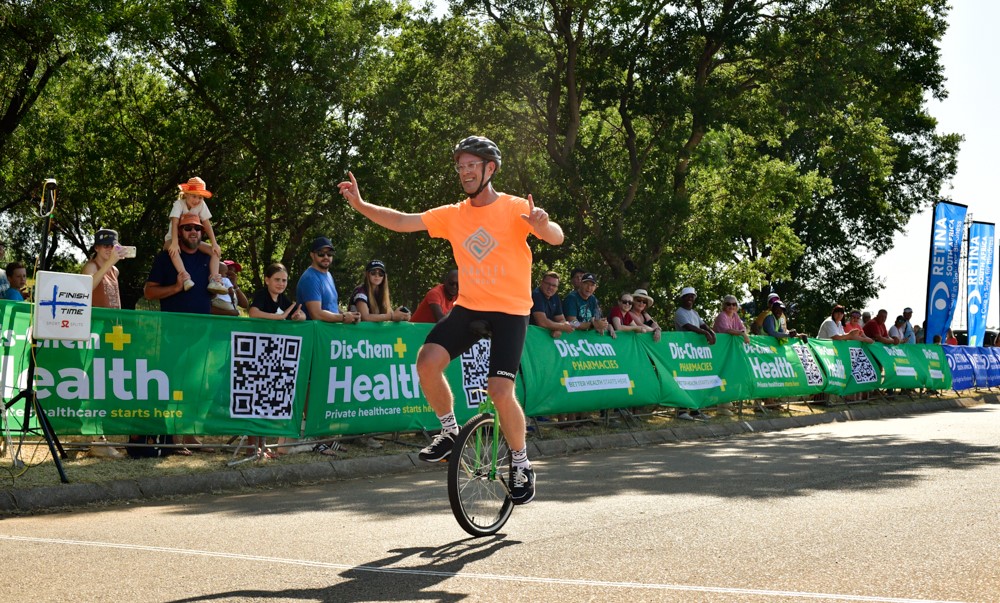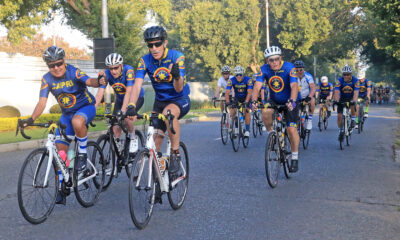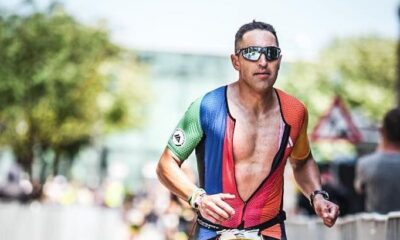
Sport

One-tyre wonders – unicyclists blaze a trail
It’s not every day you see a rabbi riding a unicycle, but those at Sandringham Gardens in Johannesburg will attest to the fact that Chevrah Kadisha Group Rabbi Jonathan Fox certainly isn’t an everyday kind of rabbi.
In fact, he was the only competitor on a one-wheeled vehicle at the sweltering Boksburg Stadium in the Dis-Chem Ride for Sight 8km Fun Ride on 18 February.
“When I saw that there was an 8km charity fun ride, I immediately entered in the hope of finishing in one piece,” Fox says. “I had never cycled more than 4km in one ride. I was elated to complete the distance, and hope to do longer distances in the future.
“When a friend of mine emigrated two years ago, he offered his unicycle to me and challenged me to learn to ride it,” Fox says. “He’s an avid cyclist, and bought a unicycle as a new challenge. For various reasons, he wasn’t able to master it, so he paid it forward to a friend.”
Fox’s fellow South African unicyclist, Jude Kapeluschnik, who matriculated from Redhill School in Johannesburg last year, also discovered a passion for cycling on one wheel, and wants to notch up the Guinness World Record of being the first person to go around the world on a unicycle.
Ed Pratt, setting forth from England as a 19-year-old, previously accomplished this feat over three years, but the Guinness World Record is still up for grabs. “They say you’re not allowed to take more than a two-week break, and he took a six-month break because the weather got really bad and the roads were too slippery,” Kapeluschnik says.
Kapeluschnik hopes to circumnavigate the globe at some point in the future. “It’s not a short-term goal,” he says. “I’m also going to start a unicycle foundation. Pratt did it for some organisation, and I decided that I was going to donate unicycles to rural areas for kids to use and potentially for people to use to commute. When I’m riding on the road, I often see these kids who live in poverty-stricken areas, and they always take a keen interest in my unicycle.”
Kapeluschnik was inspired to take up unicycling after seeing a family friend of his riding a small unicycle. “When it was his Barmitzvah, we went to his house to do some photos, and he was showing us how he rode it, so the thought of unicycling had always been in my mind, and then for my birthday a few years ago, my parents decided to get me one.”
He set about learning to ride it without getting advice from anybody or even watching YouTube tutorials. “Looking back, this was probably not the wisest decision,” he admits.
He went to the park during the COVID-19 lockdown, and initially had no luck, but didn’t give up. “For the first three hours, I made absolutely no progress. I just kept on falling. After the three-hour mark, I did about an hour a day. I started unicycling for a few metres. That sparked the motivation to keep learning.”
Similarly, Fox suffered many failed attempts and lots of falls in the early days of learning to ride a unicycle even though he had watched YouTube videos. He eventually got it right, and became hooked on riding longer distances.
Fox rides about 2km by himself in quiet parking lots almost daily. “It was particularly meaningful for me to take part in the Dis-Chem Ride for Sight cycling event, which raises money for Retina South Africa, a nongovernmental organisation that focuses on age-related macular degeneration and other visual impairments,” he says.
The encouragement and support he has received has been “overwhelming, as most people, even cyclists, have never seen a person cycling long-distance on a unicycle”.
Fox wants to teach others how to ride a unicycle. He suggests that beginners hold onto a post or a wall, try a few pedals, and be prepared to fall. “It took me three months of daily practice and many falls to be able to mount the unicycle without assistance and be able to ride without falling. I practised in my garden so that I wouldn’t hurt myself when I fell. The hardest part is getting going. Once you’re riding, the balancing becomes easier.”
Fox says unicycling is quite rare in South Africa, but you’ve still got more chance of spotting a unicyclist than a unicorn. A WhatsApp group, AmaOneTyre, has about 80 unicyclists from around the country.
Kapeluschnik is on two WhatsApp groups with a whole bunch of unicyclists. “I’m on the Cape Town group and the Johannesburg one, so I occasionally meet up with unicyclists, but I mostly ride by myself,” he says.
He frequently uses unicycling to commute. “I rode it to school in Joburg once a week. It was about an hour’s journey.” He has three different unicycles. “Two of them are more for commuting, and the other one is a performance unicycle, which is seven feet tall. I’ve been practising with it because I got that one recently.”
Unicycling is traditionally associated with the circus, parades, carnivals, and street festivals. Clowns can be seen juggling while riding unicycles. Even acrobatic performers ride them across a tightrope.
There are different types of unicycles such as touring/commuting unicycles; freestyle unicycles; muni (mountain) unicycles; and seatless unicycles. Although it can be difficult to ride the handle-less bike, you can get a mini handlebar at the front with a brake.
“Riding a unicycle is excellent exercise,” Fox says. “It strengthens the core and the thighs and improves your sense of balance. Being able to master a new skill over the age of 50 has been very rewarding, and it’s important for mental health to have goals.”
Fox says South Africans can order a unicycle through SA Unicycling Mix’s Donna Kisogloo, who gets them from overseas. “Otherwise, one can buy directly online from overseas.”
Anyone interested in learning to unicycle can contact Rabbi Fox at rabbij@jhbchev.co.za for guidance.










